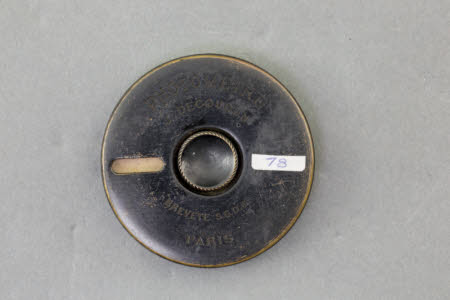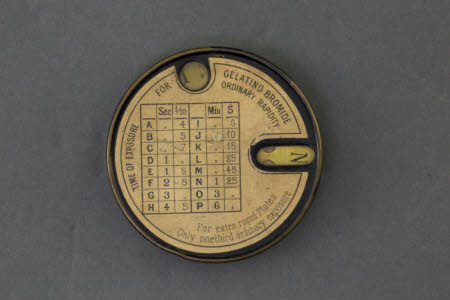Light Meter by J Decoudun
Category
Photographic technology
Date
1887
Materials
Glass, Paper
Order this imageCollection
Fox Talbot Museum, Wiltshire
NT 1525007
Summary
Light Meter by J Decoudun A brown metal disc early light meter with a paper back. Meter Type: Extinction. Calibration: Exposure range: 4/10s - 6m. The meter is held against the ground glass screen and rotating the front central knob positions one of sixteen holes in the viewing slot. A letter, from A to P is associated with each hole, and can be seen when looking at the back of the meter. Each hole admits a different amount of light through the instrument. The extinction point is when three small holes become indistinct whilst a larger hole can still be seen. This gives a value which is then found in a table giving the exposure time required, the reading is taken with the working aperture set on the lens. The text on the printed label is in English. In Britain the meter was sold by the London Stereoscopic Co. The Photometre, introduced in 1888 and manufactured by J. Decoudun of Paris, On the front of the disc above the central knob are the words "Photometre" "J Decoudun and below the knob are the words "Brevete S.G.D.G., PARIS"in A small narrow window is to the left of the central knob. On the back are two small windows with clear glass covers. From one the letters can be read and the other the viewing window. In the centre is a table from which the exposure times can be calculated. In addition are the words "For extra rapid Plates only one third ordinary exposure" and also "For Gelatino Bromide Ordinary Rapidity"
Provenance
Part of the Fenton Collection. A gift from British Film Institute in 2017. From 1986-1999, part of BFI collection for the Museum of the Moving Image. BFI purchased collection in 1986 from James Fenton's Museum of Photography, Port Erin, Isle of Man 1976-1986.

